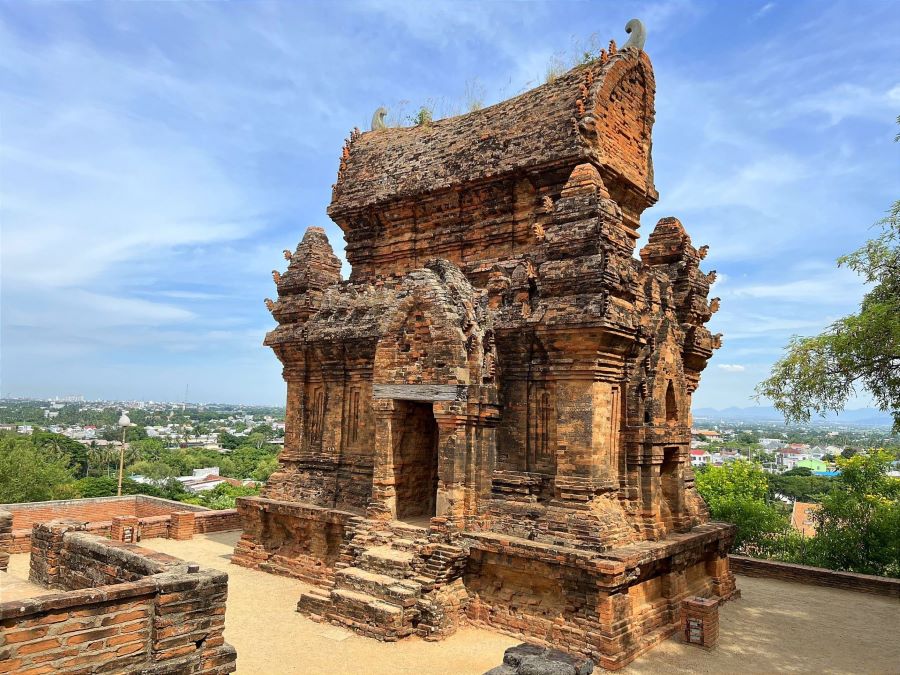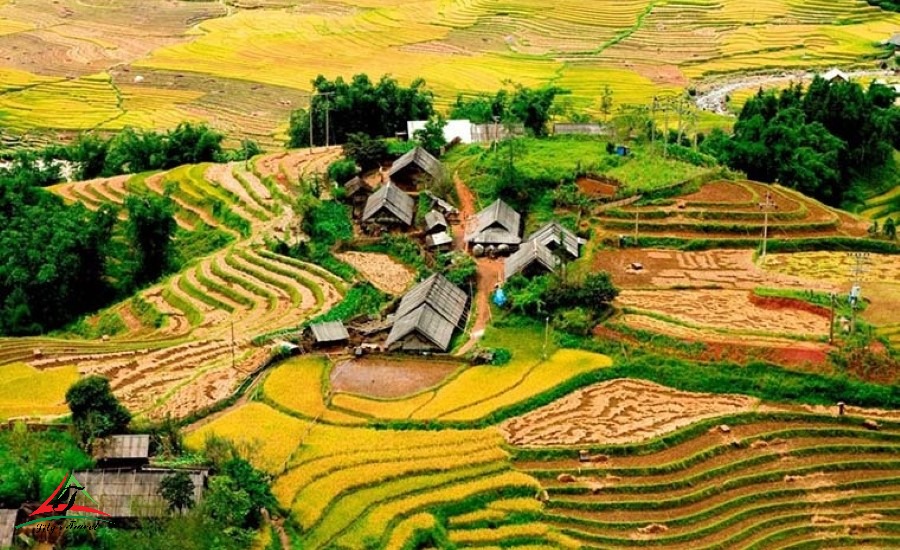Why visit Lao Cai? Top 8 Reasons to Explore Northern Vietnam
Lao Cai in northern Vietnam, is known for its breathtaking landscapes such as gorgeous terraced rice fields, Fansipan mountain – the roof of Indochina, and its rich historical and cultural heritage.
Why visit Lao Cai? This province has long been renowned for its diverse natural landscapes, offering stunning scenery with majestic mountains, lush green forests, and vast golden terraced fields nestled near the mountain peaks.
Located in northern Vietnam, Lao Cai shares a border of 180 km with China and is home to many Vietnamese ethnic groups in regions such as Sapa, Bac Ha, Bat Xat,…, making it a perfect destination when discovering Vietnam. Let’s find out the reasons why you should visit Lao Cai in the article below.
1. Enchanting natural beauty of Lao Cai

Stunning Muong Hoa Valley in Lao Cai
Located over 300 km from the capital Hanoi, with a road journey of about 6 hours, Lao Cai is a highland province bordering China to the north, with Van Nam province, Lai Chau province to the west, Ha Giang province to the east, Yen Bai and Son La provinces to the south.
The terrain here is diverse, including valleys, low and high mountains, offering the wild beauty of nature. Iconic are the immense towering mountains, providing majestic scenery alongside rich and diverse vegetation. Additionally, you can admire the terraced fields turning golden on the mountainsides in September, creating a picturesque natural scene.
2. Terraced fields during the rice season
If you are seeking peace and fresh air away from the hustle and bustle of the urban area, then Lao Cai is a must-visit destination when traveling to Northern Vietnam. Among them, the Y Ty rice terraced fields located in Bat Xat district, about 100 km from the city center of Lao Cai, are one of the reasons why you should visit Lao Cai.
When visiting this place, you will have the opportunity to witness the lush terraced fields or the golden fields when the rice is ripe. A piece of advice is to visit the terraced fields during the rice season, you should visit Lao Cai in September or October.

Y Ty terraced fields in October
Furthermore, tourists may also encounter images of the simple and genuine local people. The harmonious combination of nature and the hands of the Lao Cai people has created a magnificent scenery for the terraced rice fields. This makes anyone who looks at it amazed and impressed by the tranquil yet vibrant beauty of Y Ty rice terraced fields in Lao Cai.
3. Cultural diversity of Vietnamese ethnic groups
Lao Cai is home to 27 ethnic minority groups, accounting for half of the total number of ethnic groups in Vietnam. The diversity of cultures among these ethnic groups is one of the reasons why we should visit Lao Cai.
In the lowlands, we find the Tay, Thai, Giay, and Nung peoples, living in villages along river valleys and streams, creatively preserving the traditional culture of wet rice cultivation.
In the midlands, the Khang, La Ha, Phu La… cultivate a culture of farming with indigenous knowledge suitable for hill and forest economies.
In the highlands, the Mong, Ha Nhi, and Dao peoples transform mountain slopes into majestic terraced fields ascending towards the sky. The diversity and richness of culture are evident in both material and non-material aspects.

Lolo people in Lao Cai
4. Mild weather conditions, favorable for year-round tourism
Thanks to its geographical location and terrain, Lao Cai enjoys a cool climate throughout the year, making it suitable for visiting at any time. However, the best times to visit Lao Cai are from March to May and from September to November.
If you want to admire Lao Cai during the early rice season, with lush green terraces, you should travel from March to May. September to November is the time when Lao Cai is in the ripe rice season, and it’s also the best time to visit its terraced fields. You’ll have the chance to admire the shimmering golden terraced fields on the mountainsides.
You should note that from June to August is the rainy season in Lao Cai, so there may be 1-2 heavy rains lasting 1-2 days per week. You should check the weather before traveling here. From December to February is the coldest time of the year in Lao Cai. Particularly, snowfall may occur on the peaks of Fansipan and Sapa. Therefore, you should prepare warm clothes, hats, gloves, etc.
5. Cultural events and traditional festivals in Lao Cai
Regarding traditional attire, there are 34 different styles with various colors and materials. Particularly noteworthy are the unique festivals in Lao Cai. These festivals include a wide variety of ceremonies such as crop praying festivals, ceremonies venerating sun and water deities to ensure a fruitful harvest and forest protection.
There are also festivals commemorating historical resistance against foreign invasion, celebrating the ancient cultural identity of the Vietnamese people. Festivals are held throughout the four seasons of Spring, Summer, Autumn, and Winter. In particular, the summer in the highland villages of Lao Cai is considered the season of festivals.

Spring festival in Lao Cai
Furthermore, this year, Lao Cai will organize many cultural festivals such as the Traditional Horse Racing Festival in Bac Ha, the Traditional Costume Week of Vietnamese ethnic groups in Bao Yen, etc., to attract many tourists to visit.
6. Spiritual tourism in Lao Cai
Why visit Lao Cai? There are many ancient and sacred temples such as the Thuong Temple, Bao Ha Temple, and spiritual complexes on the top of Fansipan Mountain, ideal for those who love to explore spirituality.
Visitors can visit the Thuong Temple, a historical site with over 300 years of history since the time of the Le Dynasty, to commemorate the heroic feats of talented generals who defeated northern invaders, defending the Vietnamese territory. Or the Mau Thuong Temple in Lao Cai, one of the three famous temples in Sapa town. Built in mountain-back architecture with a history of over 200 years, the Mau Thuong Temple is hidden in the green forest, exuding a fresh, peaceful atmosphere with the scent of incense wafting in the air.

The Great Amitabha Buddha on top of Fansipan
The most iconic stop in the spiritual journey in Lao Cai, the Fansipan spiritual complex is an unmissable destination. Locals consider it the soul of Fansipan Mountain. Especially, on the top of Fansipan Mountain, there is a giant bronze statue of The Great Amitabha Buddha, believed to be the highest seated Buddha statue in Asia, overlooking the vast blue sky and white clouds. Especially, the beginning of the year, from January to March, is the spring in Vietnam, with many spiritual festivals deeply imbued with the culture of the Lao Cai people for tourists to participate in.
7. Trekking to the Fansipan mountain, conquering the roof of Indochina
If you are an adventure lover, trekking to the Fansipan mountain is one of the reasons why you should visit Lao Cai. With an altitude of 3,143 meters above sea level, climbing Fansipan can take about 2 to 7 days depending on one’s skills and physical condition. The first 2,000 meters of the trail are quite easy, but after that, the path becomes steep and slippery.

Fansipan mountain in Lao Cai
Fansipan’s peak features high mountainous terrain, and the ideal time for trekking this mountain is from September to April. Additionally, if you climb Fansipan around March to April, you will be able to admire the vibrant blooming of azaleas. Alternatively, climbing Fansipan in winter offers the magical experience of “cloud hunting.”
Fansipan’s peak has rugged, steep sections that can be very slippery if you are not careful, especially when it is foggy. If you do not want to undertake the adventure of climbing Fansipan but still wish to conquer the summit quickly, you can opt for the Fansipan cable car, which takes only about 20 minutes instead of the two days required for hiking.
8. Unique Cuisine in Lao Cai
Lao Cai is renowned for its majestic natural scenery and tourist destinations that attract visitors from all over. Among these attractions, the cuisine is also a compelling reason why visit Ha Giang. For example, the famous rainbow trout in Sapa has a rich and delicious flavor, beautiful pink flesh, and high nutritional value, drawing in every visitor who visit Lao Cai.
Bac Ha sour pho is one of the iconic dishes representing Lao Cai cuisine. Although sour pho is a simple, rustic dish, it embodies the cultural essence of the highland people of Bac Ha – Lao Cai. The broth for sour pho undergoes a rather elaborate process, including fermentation with various ingredients to achieve a certain level of sourness.

Cuisine of Lao Cai
Lao Cai pork is another specialty of the region. The pigs are raised freely on the mountains and then sold at many ethnic markets. The pork is firm and flavorful, and it is prepared into delicious dishes such as steamed, grilled, stir-fried, etc. Additionally, Lao Cai is known for its famous rice wine from the Northwest mountains, which makes a great gift for visitors.
Read more:
Start planning your tailor-made Vietnam tour by contacting one of our specialists…







